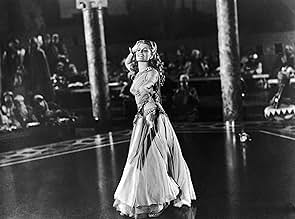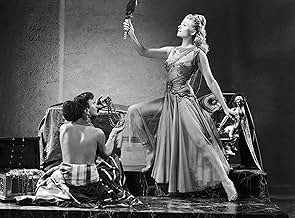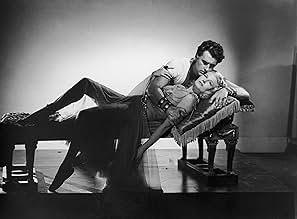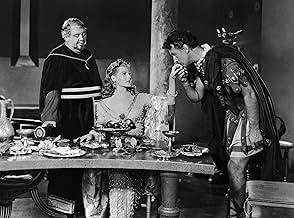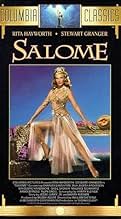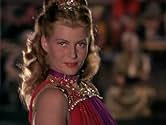IMDb-BEWERTUNG
5,8/10
2427
IHRE BEWERTUNG
Füge eine Handlung in deiner Sprache hinzuAfter her banishment from Rome, Jewish Princess Salome returns to her Roman-ruled native land of Galilee, where prophet John the Baptist preaches against Salome's parents, King Herod and Que... Alles lesenAfter her banishment from Rome, Jewish Princess Salome returns to her Roman-ruled native land of Galilee, where prophet John the Baptist preaches against Salome's parents, King Herod and Queen Herodias.After her banishment from Rome, Jewish Princess Salome returns to her Roman-ruled native land of Galilee, where prophet John the Baptist preaches against Salome's parents, King Herod and Queen Herodias.
- Auszeichnungen
- 1 Nominierung insgesamt
Cedric Hardwicke
- Tiberius Caesar
- (as Sir Cedric Hardwicke)
David Ahdar
- Convert
- (Nicht genannt)
Ray Beltram
- Herod's Council Member
- (Nicht genannt)
Bobker Ben Ali
- Politician
- (Nicht genannt)
Frederic Berest
- Sailor
- (Nicht genannt)
Barry Brooks
- Roman Guard
- (Nicht genannt)
Bruce Cameron
- Guard
- (Nicht genannt)
Eduardo Cansino
- Roman Guard
- (Nicht genannt)
Tristram Coffin
- Guard
- (Nicht genannt)
Bud Cokes
- Galilean Soldier
- (Nicht genannt)
Empfohlene Bewertungen
As we all know that Princess Salome,(Rita Hayworth) danced for King Herod,(Charles Laughton) in order to gain his favor and requested that John the Baptist's head would be removed and placed on a silver platter and given to the king. However, Hollywood changed the Bible version and made Salome look like a kind and loving Princess who loved the Christian way of thinking and living and wanted to save John The Baptist from being killed. Stewart Granger,(Commander Claudis) soon become the lover of Princess Salome after she had fought with him constantly and told him she wanted nothing to do with a Roman. King Herod and Queen Herodus (Judith Anderson)was living in adultery since she was married to another man and living with King Herod. Rita Hayworth was an experienced dancer and this was one of her best films in 1953.
Although other films from the same period might be expected to receive a higher priority because they remain more significant today, it seems amazing that this film has never been released as a DVD. Salome is highly viewable, and anyone simply wanting to pass an evening by watching a light entertaining film without regard to its message or social significance would probably find it an excellent choice. Such films are among the most successful in video rental stores or as casual purchases from store displays - consequently they bring in the greatest returns for companies creating new DVD's from old films and are often selected in preference to much more significant works.
What does Salome have going for it?. Firstly a good Technicolor print of the type which provides endlessly enjoyable images of the seas, skies and scenery so plentiful in the Mediterranean. Next a very popular duration of around 100 minutes, a story which is widely known and a one word title equally readily recognised. Thirdly a cast largely composed of great Hollywood stars of the period - a major selling point usually far more important than the filmscript, direction or historical accuracy; and finally an electrifying near striptease performance by a star who has been referred to as the Hollywood love goddess of the period. To set against all this were the very poor reviews by most critics who condemned it for gross overacting, poor dialogue, unimaginative direction and historical inaccuracy - all of which experience suggests is of less importance than the cast for most viewers (even those who study the critics), when they are simply looking for an enjoyable and relaxing evening.
Furthermore some of these criticisms are not easily sustained. 'Overacting' is a qualitative term which first became important when the introduction of talkies in the 1930's made the exaggerated actions and gestures of the silent era no longer necessary. Stage actors are trained to overact so the distant members of their audience seated far away 'up in the gods' can better follow what is going on. Done carefully this type of overacting can be very effective in films with rather melodramatic story lines, and is often referred to as 'chewing up the scenery'. There is a lot of this in Salome, not only from John the Baptist but also from both Herod and Herodias. Watching Charles Laughton, as a very lecherous Herod, lasciviously rolling his eyes and drooling at the mouth when Salome dances is one of the great joys of this film. It is true that Rita Hayworth was probably too old to play a character historically believed to have been so much younger, and she certainly did not look the part of a Semitic princess, but she was trained as a dancer from infancy and it is unlikely that the film would have the same appeal today if any other Hollywood star of the period had been given the role.
Historical inaccuracies are much more controversial. I take a very strong objection to incorrect representations of what is factually established history unless it is made clear that this is being done. Here however historical records seem to be rather limited and not entirely self consistent, so some judgment is called for. Most of what we believe we know about Salome probably comes from records that are more literary than historical. For hundreds of years much current literature comprised re-writing and fleshing out known stories which might have originated as oral history, legend, myth or pure fiction. In this case an additional complication is that the most widely known contemporary reference come from the Bible rather than from a work solely written as history - something that often leads to public reactions based more on emotion than on fact. Herod, Herodias and Herodias's daughter are well authenticated historical characters, but doubts have even been raised as to whether the latter was actually named Salome (some sources refer to her having the same name as her mother). History points to her age at the time as being 13 or 14 but this is by inference rather than definite records. The account of Salome dancing before Herod occupies about 200 words in each of the gospels of Mark and Matthew in the Bible. There is also a brief historical record of this dance and its outcome written by the Roman-Jewish historian Josephus. The story in this film reverses the biblical story which indicates that Salome had no idea what reward to seek from Herod after dancing for him, but at the request of her mother agreed to ask for John's head. The reversal was demanded by a Columbia Studio head who did not want his star tagged with the label of a very bad girl, but historically it can also be found in Jules Massenet's opera "Herodiade". In a film intended purely as a piece of entertainment this reversal would be justifiable artistic licence so long as the change from the normally accepted story was clearly indicated. Since this was not done, the film has been mercilessly but rather unfairly shredded by critics and viewers ever since. Nobody today would view it to learn the story and for those merely seeking an enjoyable evening's viewing, it is inconsequential. If a similar film had depicted a legend about which little was known historically, there would have been much less controversy and, despite all its faults, the film would probably have remained much more highly regarded right up to today (with copies on DVD readily available in almost every video store). Anyone who wishes to view a more structured reconstruction of this story should watch the fine Ken Russell film based on the play by Oscar Wilde (or even Nazimova's 1923 silent film), but for an evening's light, enjoyable entertainment without heavy psychological musings choose this 1953 film.
What does Salome have going for it?. Firstly a good Technicolor print of the type which provides endlessly enjoyable images of the seas, skies and scenery so plentiful in the Mediterranean. Next a very popular duration of around 100 minutes, a story which is widely known and a one word title equally readily recognised. Thirdly a cast largely composed of great Hollywood stars of the period - a major selling point usually far more important than the filmscript, direction or historical accuracy; and finally an electrifying near striptease performance by a star who has been referred to as the Hollywood love goddess of the period. To set against all this were the very poor reviews by most critics who condemned it for gross overacting, poor dialogue, unimaginative direction and historical inaccuracy - all of which experience suggests is of less importance than the cast for most viewers (even those who study the critics), when they are simply looking for an enjoyable and relaxing evening.
Furthermore some of these criticisms are not easily sustained. 'Overacting' is a qualitative term which first became important when the introduction of talkies in the 1930's made the exaggerated actions and gestures of the silent era no longer necessary. Stage actors are trained to overact so the distant members of their audience seated far away 'up in the gods' can better follow what is going on. Done carefully this type of overacting can be very effective in films with rather melodramatic story lines, and is often referred to as 'chewing up the scenery'. There is a lot of this in Salome, not only from John the Baptist but also from both Herod and Herodias. Watching Charles Laughton, as a very lecherous Herod, lasciviously rolling his eyes and drooling at the mouth when Salome dances is one of the great joys of this film. It is true that Rita Hayworth was probably too old to play a character historically believed to have been so much younger, and she certainly did not look the part of a Semitic princess, but she was trained as a dancer from infancy and it is unlikely that the film would have the same appeal today if any other Hollywood star of the period had been given the role.
Historical inaccuracies are much more controversial. I take a very strong objection to incorrect representations of what is factually established history unless it is made clear that this is being done. Here however historical records seem to be rather limited and not entirely self consistent, so some judgment is called for. Most of what we believe we know about Salome probably comes from records that are more literary than historical. For hundreds of years much current literature comprised re-writing and fleshing out known stories which might have originated as oral history, legend, myth or pure fiction. In this case an additional complication is that the most widely known contemporary reference come from the Bible rather than from a work solely written as history - something that often leads to public reactions based more on emotion than on fact. Herod, Herodias and Herodias's daughter are well authenticated historical characters, but doubts have even been raised as to whether the latter was actually named Salome (some sources refer to her having the same name as her mother). History points to her age at the time as being 13 or 14 but this is by inference rather than definite records. The account of Salome dancing before Herod occupies about 200 words in each of the gospels of Mark and Matthew in the Bible. There is also a brief historical record of this dance and its outcome written by the Roman-Jewish historian Josephus. The story in this film reverses the biblical story which indicates that Salome had no idea what reward to seek from Herod after dancing for him, but at the request of her mother agreed to ask for John's head. The reversal was demanded by a Columbia Studio head who did not want his star tagged with the label of a very bad girl, but historically it can also be found in Jules Massenet's opera "Herodiade". In a film intended purely as a piece of entertainment this reversal would be justifiable artistic licence so long as the change from the normally accepted story was clearly indicated. Since this was not done, the film has been mercilessly but rather unfairly shredded by critics and viewers ever since. Nobody today would view it to learn the story and for those merely seeking an enjoyable evening's viewing, it is inconsequential. If a similar film had depicted a legend about which little was known historically, there would have been much less controversy and, despite all its faults, the film would probably have remained much more highly regarded right up to today (with copies on DVD readily available in almost every video store). Anyone who wishes to view a more structured reconstruction of this story should watch the fine Ken Russell film based on the play by Oscar Wilde (or even Nazimova's 1923 silent film), but for an evening's light, enjoyable entertainment without heavy psychological musings choose this 1953 film.
Salome certainly isn't a terrible film, far from it. But I do think, as a biblical epic it is flawed in many ways. The costumes and the scenery were a joy to the eyes, and the music was beautiful and a treat to the ears. The acting is pretty good too, with Stewart Granger handsome in his role, and Judith Anderson deliciously cruel as Herodias, though Anderson to be fair has given better performances in classics like And Then There Were None and Rebecca. Charles Laughton gives one of his career's weakest performances, but he is good as King Herod to some extent. The film's portrayal of John the Baptist from Alan Badel was also fine, but Salome's creme de la creme is Rita Hayworth in the title role. Entirely captivating and so beautiful, and she danced beautifully in Dance of the Seven Veils which also happens to be a scene from Richard Strauss's opera of the same name. However, the film's flaws include pedestrian pacing, an underdeveloped script and a story that suffers from a lot of tampering. Overall, deeply flawed, but watchable biblical film, that is worth watching if only for Hayworth and Dance of the Seven Veils. 6/10 Bethany Cox
The reason why you 'd like to sit through this is the four leads:Rita Hayworth ,ideally cast as Salome ,a libidinous Charles Laughton ,a cruel Judith Anderson and a noble Stewart Granger.Plus a stint by Sir Cedric Hardwicke.Plus the director of the best version of "hunchback of Notre -Dame" at his kitchiest.Plus a fabulous dance of the seven veils.Plus gaudy colors and John the Baptist's head of course.
But what remains,eg the essential ,is a really "free' adaptation of the holy writs.The script writers invented a Roman soldier with whom Salome falls in love.BUT what will puzzle the Christians is that Salome dances not to get John's head,but to save him!!!.A happy end which will remind you of your Sunday school days.And that's not all:the plot even involves Pontius Pilate whom Claudius (Granger) urged to become a Christian and to repent so that he would go down in history as a soldier of a brand new religion.Well the man did not wash his hands ,but he did not do what he was told either...which did not prevent him from going down in history anyway..
But what remains,eg the essential ,is a really "free' adaptation of the holy writs.The script writers invented a Roman soldier with whom Salome falls in love.BUT what will puzzle the Christians is that Salome dances not to get John's head,but to save him!!!.A happy end which will remind you of your Sunday school days.And that's not all:the plot even involves Pontius Pilate whom Claudius (Granger) urged to become a Christian and to repent so that he would go down in history as a soldier of a brand new religion.Well the man did not wash his hands ,but he did not do what he was told either...which did not prevent him from going down in history anyway..
the first temptation is to criticize it. very hard. and it is the normal reaction. because the film has potential and the right cast. but for director seems be more seductive the easy way. the dance of Rita Hayworth, the sketch of the force of Charles Laughton, Judith Anderson in a role as game of stereotypes. the result - not the best. after decades, it is not a real sin and it is a wise option to see it as piece from a long chain of religious/historical films from the "50. but the case of "Salome" remains different. for the simple motif than it is not an ordinary film from the "50. and only way to discover it out of not inspired solution of script or director vision is ... to imagine it.
Wusstest du schon
- WissenswertesThis was the last movie produced by Rita Hayworth's production company, the Beckworth Company. Hayworth later called her "Dance of the Seven Veils" in this movie, "the most demanding of my entire career", and said it required "endless takes and retakes."
- PatzerIn Palestine, Claudius saves Salome from a gila monster, a venomous lizard found only in southwestern North America.
- Zitate
Queen Herodias: The desperate can only survive by taking desperate measures.
- Crazy CreditsAt the end of the picture, rather than seeing the words The End on the screen, we see a title that says This was The Beginning.
- VerbindungenEdited into Haut den Herkules (1962)
Top-Auswahl
Melde dich zum Bewerten an und greife auf die Watchlist für personalisierte Empfehlungen zu.
- How long is Salome?Powered by Alexa
Details
- Laufzeit
- 1 Std. 43 Min.(103 min)
- Seitenverhältnis
- 1.37 : 1
Zu dieser Seite beitragen
Bearbeitung vorschlagen oder fehlenden Inhalt hinzufügen


